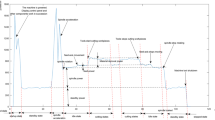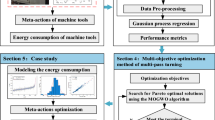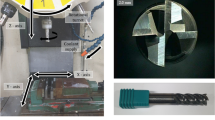Abstract
The machining unit of hobbing machine tool accounts for a large portion of the energy consumption during the operating phase. The optimization design is a practical means of energy saving and can reduce energy consumption essentially. However, this issue has rarely been discussed in depth in previous research. A comprehensive function of energy consumption of the machining unit is built to address this problem. Surrogate models are established by using effective fitting methods. An integrated optimization model for reducing tool displacement and energy consumption is developed on the basis of the energy consumption function and surrogate models, and the parameters of the motor and structure are considered simultaneously. Results show that the energy consumption and tool displacement of the machining unit are reduced, indicating that energy saving is achieved and the machining accuracy is guaranteed. The influence of optimization variables on the objectives is analyzed to inform the design.

Similar content being viewed by others
Abbreviations
- a :
-
Distance between the two sliders
- a p :
-
Cut depth
- A :
-
Surface area of the motor core
- B :
-
Equivalent viscous friction damping coefficient
- B sm :
-
Servo motor damping coefficient
- c 1, c 2 :
-
Learning factors
- d h :
-
Hob outer diameter
- Dim :
-
Particle dimension
- E :
-
Energy consumption of the machining unit
- E k :
-
Kinetic energy of mechanical transmission components
- f BA :
-
Basic frequency of the inverter
- f c :
-
Coulomb friction force
- f i :
-
ith order natural frequency of the machine tool after optimization
- [f i]:
-
ith order natural frequency before optimization
- f v :
-
Viscous friction force
- f z :
-
Axial feed of the hob
- F c :
-
Cutting force
- F cz :
-
Cutting force on the slide plate
- F f :
-
Friction force between the sliding plate and the vertical guide rail
- F N :
-
Normal force on the guide rail
- F t :
-
Slide plate load force
- g :
-
Gravitational acceleration
- h :
-
Heat dissipation coefficient
- J 1, J s, J sm :
-
Moments of inertia of the coupling, ball screw, and servo motor, respectively
- J s*:
-
Moment of inertia equivalent to the motor shaft of the transmission system
- K 1, K 2, K 3 :
-
Coefficients associated with the materials, hardness, and helical angle of the gear, respectively
- l 1 :
-
Distance between the barycenters of the slide plate and the axis of the ball screw
- l 2 :
-
Distance between the barycenters of the tool post and the axis of the ball screw
- l 3 :
-
Distance between the barycenters of the main gearbox and the axis of the ball screw
- l 4 :
-
Distance between the barycenters of the additional component and the axis of the ball screw
- l 5 :
-
Distance between the barycenters of the hob and the axis of the ball screw
- L b :
-
Ball screw lead
- m :
-
Normal modulus of the hob
- M, M a, M c, M h :
-
Masses of the machining unit, additional components
- M k, M t :
-
main gearbox, slide plate, tool post shell, and tool post support plate, respectively
- M 0 :
-
Equivalent nonload Coulomb friction moment
- Mit :
-
Maximum iteration number
- n* :
-
Initial speed before the motor is accelerated
- n gm :
-
Hob speed
- n N :
-
Rated speed of the motor
- n N1, n N2 :
-
Rated speeds of the main and servo motors, respectively
- n sm :
-
Servo motor speed
- N i :
-
Motor speed under working condition i
- Nip :
-
Initial population number
- N s :
-
Number of samples
- p :
-
Number of pole pairs of the motor
- P :
-
Power of the machining unit
- P ad-i :
-
Additional loss power under working condition i
- P c :
-
Cutting power
- P Cu :
-
Peak copper loss power
- P Cu-i :
-
Copper loss power under working condition i
- P e :
-
Peak eddy current loss power
- P e-i :
-
Eddy current loss power under working condition i
- P h :
-
Peak hysteresis loss power
- P h-i :
-
Hysteresis loss power under working condition i
- P loss :
-
Peak loss power of the motor
- P loss-i :
-
Motor loss power under working condition i
- P m-i :
-
Mechanical loss power under working condition i
- P max :
-
Peak power of the motor
- P max1, P max2 :
-
Peak powers of the main and servo motors, respectively
- P mec :
-
Mechanical loss power
- P mo :
-
Main motor output power
- P n-i :
-
Motor input power under working condition i
- P N :
-
Rated power
- P N1 :
-
Rated power of the main motor
- P N2 :
-
Rated power of the servo motor
- P sm :
-
Servo motor output power
- P o-i :
-
Motor output power under working condition i.
- P SA :
-
Motor acceleration power
- P SR :
-
Motor shaft rotation power
- sgn(·):
-
Symbolic function
- t :
-
Operation time of the machine tool.
- t*:
-
Duration of the rotation acceleration
- t A :
-
Acceleration time of the inverter
- t r :
-
Limit value of temperature rise
- T b :
-
Frictional moment generated by the bearing preload
- T i :
-
Motor output torque under working condition i
- T l :
-
Coupling output torque
- T sm :
-
Servo motor output torque
- T t :
-
Output torque of the ball screw
- T z :
-
Input torque of the ball screw
- Τ :
-
Output threshold vector
- v c :
-
Cutting speed
- V z :
-
Axial feed speed of the moving components along the Z axis
- x :
-
Sample data set
- x i, x j :
-
Sample points
- x 1, x 2, x 3, x 4, x 5 :
-
Structure parameters of the tool post support plate
- ŷ :
-
Fitting expression of y
- Z :
-
Tooth number of the workpiece
- α :
-
Load factor of the mechanical transmission system
- α*:
-
Motor angular acceleration
- γ i :
-
ith observed value
- \(\gamma _i^ \ast \) :
-
ith predicted value
- \({{\bar \gamma }_i}\) :
-
Mean value of the ith observed value
- δ :
-
Tool displacement
- ς(·):
-
Global prediction polynomial
- Θ(·):
-
Random error
- κ(·):
-
Radial basis function
- η b :
-
Bearing transmission efficiency
- η m, η sm :
-
Motor efficiencies of the main and servo motors, respectively
- η z :
-
Ball screw transmission efficiency
- η(i):
-
Motor efficiency under working condition i
- µ c :
-
Coulomb friction coefficient
- µ v :
-
Viscous friction coefficient
- χ :
-
Center of κ(·)
- ω * :
-
Angular velocity of the motor
- ω end, ω int :
-
Final and initial values of the inertia weight, respectively
- ω m :
-
Angular velocity of the spindle motor shaft
- ω sm :
-
Servo motor output angular velocity
- ξ 0, ξ i, ξ ij :
-
Undetermined coefficients of the RSM model
- ℓ(·):
-
Linear polynomial function
- ħ 2 :
-
Variance of Θ(·)
- Ξ(·):
-
Correlation function
- ϑ k :
-
Related parameter determined by the maximum likelihood estimation
- ϖ i :
-
Adaptability weight coefficient
- ϖ 50×1 :
-
Synaptic weight matrix
- ∥·∥:
-
Euclidean norm
References
Triebe M J, Zhao F, Sutherland J W. Genetic optimization for the design of a machine tool slide table for reduced energy consumption. Journal of Manufacturing Science and Engineering, 2021, 143(10): 101003
Zhong Q Q, Tang R Z, Peng T. Decision rules for energy consumption minimization during material removal process in turning. Journal of Cleaner Production, 2017, 140(3): 1819–1827
Papetti A, Menghi R, Di Domizio G, Germani M, Marconi M. Resources value mapping: a method to assess the resource efficiency of manufacturing systems. Applied Energy, 2019, 249: 326–342
Zhao J H, Li L, Wang Y, Sutherland J W. Impact of surface machining complexity on energy consumption and efficiency in CNC milling. The International Journal of Advanced Manufacturing Technology, 2019, 102(9): 2891–2905
Apostolos F, Alexios P, Georgios P, Panagiotis S, George C. Energy efficiency of manufacturing processes: a critical review. Procedia CIRP, 2013, 628–633
Kara S, Li W. Unit process energy consumption models for material removal processes. CIRP Annals, 2011, 60(1): 37–40
Xiao Y M, Jiang Z G, Gu Q, Yan W, Wang R P. A novel approach to CNC machining center processing parameters optimization considering energy-saving and low-cost. Journal of Manufacturing Systems, 2021, 59: 535–548
Zhang T, Liu Z Q, Shi Z Y, Xu C H. Investigation on size effect of specific cutting energy in mechanical micro-cutting. The International Journal of Advanced Manufacturing Technology, 2017, 91(5): 2621–2633
Xiao Q G, Li C B, Tang Y, Pan J, Yu J, Chen X Z. Multi-component energy modeling and optimization for sustainable dry gear hobbing. Energy, 2019, 187: 115911
Li C B, Xiao Q G, Tang Y, Li L. A method integrating Taguchi, RSM and MOPSO to CNC machining parameters optimization for energy saving. Journal of Cleaner Production, 2016, 135: 263–275
Vu N C, Dang X P, Huang S C. Multi-objective optimization of hard milling process of AISI H13 in terms of productivity, quality, and cutting energy under nanofluid minimum quantity lubrication condition. Measurement and Control, 2021, 54(5–6): 820–834
Nguyen T T, Nguyen T A, Trinh Q H. Optimization of milling parameters for energy savings and surface quality. Arabian Journal for Science and Engineering, 2020, 45(11): 9111–9125
Arriaza O V, Kim D W, Lee D Y, Suhaimi M A. Trade-off analysis between machining time and energy consumption in impeller NC machining. Robotics and Computer-Integrated Manufacturing, 2017, 43: 164–170
Sihag N, Sangwan K S. A systematic literature review on machine tool energy consumption. Journal of Cleaner Production, 2020, 275: 123125
Li B, Tian X T, Zhang M. Modeling and multi-objective optimization method of machine tool energy consumption considering tool wear. International Journal of Precision Engineering and Manufacturing-Green Technology, 2022, 9(1): 127–141
Zhang X W, Yu T B, Dai Y X, Qu S, Zhao J. Energy consumption considering tool wear and optimization of cutting parameters in micro milling process. International Journal of Mechanical Sciences, 2020, 178: 105628
He K Y, Tang R Z, Jin M Z. Pareto fronts of machining parameters for trade-off among energy consumption, cutting force and processing time. International Journal of Production Economics, 2017, 185: 113–127
Kumar R, Bilga P S, Singh S. Multi objective optimization using different methods of assigning weights to energy consumption responses, surface roughness and material removal rate during rough turning operation. Journal of Cleaner Production, 2017, 164: 45–57
Yoon H S, Kim E S, Kim M S, Lee J Y, Lee G B, Ahn S H. Towards greener machine tools—a review on energy saving strategies and technologies. Renewable and Sustainable Energy Reviews, 2015, 48: 870–891
Triebe M J, Zhao F, Sutherland J W. Achieving energy efficient machine tools by mass reduction through multi-objective optimization. Procedia CIRP, 2019, 80: 73–78
Ji Q Q, Li C B, Zhu D G, Jin Y, Lv Y, He J X. Structural design optimization of moving component in CNC machine tool for energy saving. Journal of Cleaner Production, 2020, 246: 118976
Lv J X, Tang R Z, Tang W C J, Liu Y, Zhang Y F, Jia S. An investigation into reducing the spindle acceleration energy consumption of machine tools. Journal of Cleaner Production, 2017, 143: 794–803
Wójcicki J, Bianchi G. Electric load management in spindle run-up and run-down for multi-spindle machine tools via optimal power-torque trajectories and peak load synchronization. The International Journal of Advanced Manufacturing Technology, 2018, 95(5): 1819–1835
Denkena B, Abele E, Brecher C, Dittrich M A, Kara S, Mori M. Energy efficient machine tools. CIRP Annals, 2020, 69(2): 646–667
Liu S, Liu F, Hu S H, Yin Z B. Energy survey of machine tools: separating power information of the main transmission system during machining process. Journal of Advanced Mechanical Design, Systems, and Manufacturing, 2012, 6(4): 445–455
Liu X, Zhao F, Mei X S. A fuzzy adaptive controller for constant cutting torque in high-performance gear hobbing process. In: Proceedings of 2017 IEEE International Conference on Advanced Intelligent Mechatronics (AIM). Munich: IEEE, 2017, 1725–1730
Hall E, Ramamurthy S S, Balda J C. Optimum speed ratio of induction motor drives for electrical vehicle propulsion. In: Proceedings of APEC 2001 the 16th Annual IEEE Applied Power Electronics Conference and Exposition (Cat. NO.01CH37181). Anaheim: IEEE, 2001, 371–377
Afzal A, Kim K Y, Seo J W. Effects of Latin hypercube sampling on surrogate modeling and optimization. International Journal of Fluid Machinery and Systems, 2017, 10(3): 240–253
Li C B, Li Y S, Gao L, Garg A, Li W. Surrogate model-based heat dissipation optimization of air-cooling battery packs involving herringbone fins. International Journal of Energy Research, 2021, 45(6): 8508–8523
Amouzgar K, Strömberg N. Radial basis functions as surrogate models with a priori bias in comparison with a posteriori bias. Structural and Multidisciplinary Optimization, 2017, 55(4): 1453–1469
Kleijnen J P C. Regression and Kriging metamodels with their experimental designs in simulation: a review. European Journal of Operational Research, 2017, 256(1): 1–16
Ni H X, Yan C P, Ni S F, Shu H, Zhang Y. Multi-verse optimizer based parameters decision with considering tool life in dry hobbing process. Advances in Manufacturing, 2021, 9(2): 216–234
Paul D, Jain A, Saha S, Mathew J. Multi-objective PSO based online feature selection for multi-label classification. Knowledge-Based Systems, 2021, 222: 106966
Oliveira B, Ballio F, Maia R. Numerical modelling-based sensitivity analysis of fluvial morphodynamics. Environmental Modelling & Software, 2021, 135: 104903
Xu C, Zhu P, Liu Z, Tao W. Mapping-based hierarchical sensitivity analysis for multilevel systems with multidimensional correlations. Journal of Mechanical Design, 2021, 143(1): 011707
Acknowledgements
This work was supported in part by the National Natural Science Foundation of China (Grant Nos. 51975075 and 52105506) and the Chongqing Technology Innovation and Application Program, China (Grant No. cstc2020jscx-msxmX0221).
Author information
Authors and Affiliations
Corresponding author
Rights and permissions
About this article
Cite this article
Lv, Y., Li, C., He, J. et al. Energy saving design of the machining unit of hobbing machine tool with integrated optimization. Front. Mech. Eng. 17, 38 (2022). https://doi.org/10.1007/s11465-022-0694-2
Received:
Accepted:
Published:
DOI: https://doi.org/10.1007/s11465-022-0694-2




